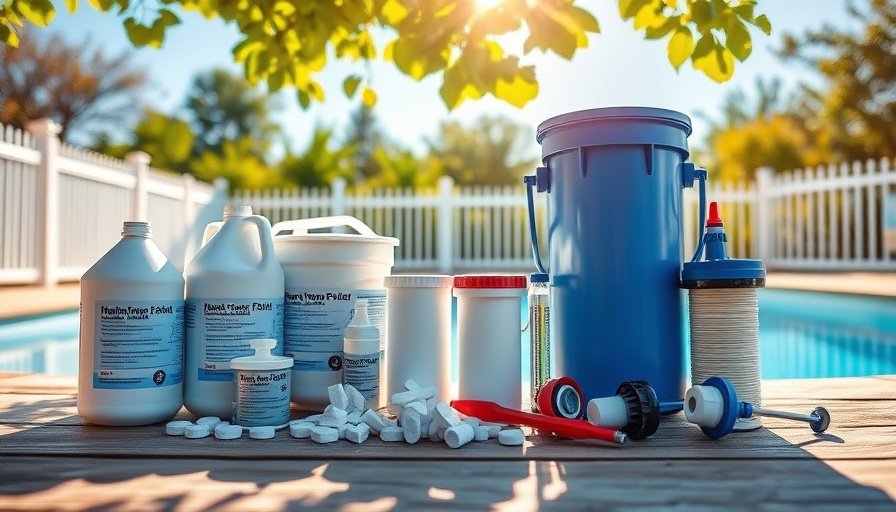
Essential Pool Chemicals Every Owner Should Prioritize
For homeowners in Fairfield County, Connecticut, ensuring that your pool remains safe and inviting is paramount, especially during the summer months. Clean and clear water is not a stroke of luck; it requires regular attention to pool chemicals. From preventing algae outbreaks to ensuring swimmer safety, knowing which chemicals to use can be the difference between a refreshing dip and a swimming pool disaster.
The Importance of Chlorine in Pool Maintenance
First up is chlorine – your primary line of defense against germs and algae. The CDC emphasizes maintaining chlorine levels between 1 and 3 parts per million (ppm) to achieve optimal effectiveness. While many pool owners choose chlorine tablets due to their slow release properties, it’s crucial to monitor these levels closely. Think of it as a marriage between chlorine and pH levels: a perfect balance is essential for longevity and hygiene.
Balanced pH: The Underpinning of Pool Chemistry
Equally vital is maintaining proper pH levels, ideally between 7.2 and 7.8. An acidic pH can sting eyes and corrode metal fixtures, while a high pH can hinder chlorine's performance, leading to cloudy water. Homeowners should regularly test their pool water using pH adjusting chemicals, such as sodium carbonate or sodium bisulfate, to fine-tune their pools.
The Role of Total Alkalinity and Calcium Hardness
To stabilize pH, total alkalinity must be monitored as well. Keeping alkalinity levels between 80 and 120 ppm will help buffer the pH fluctuations. Baking soda is the go-to solution for raising alkalinity. Furthermore, calcium hardness is crucial for protecting pool surfaces. Ideally, levels should be kept between 200 and 400 ppm, as both deficiency and excess can lead to surface damage or unsightly buildup.
Guarding Your Chlorine with Cyanuric Acid
Sunlight is a silent saboteur when it comes to chlorine's effectiveness. This is where cyanuric acid (CYA) comes in, acting as a protective shield. For outdoor pools, maintain CYA levels between 30 and 50 ppm; however, always check the labels on your chlorine tablets, as they may already contain stabilizers. Too much CYA could dilute chlorine effectiveness, which could lead to unhealthy swimming conditions.
Algaecides: The Preventative Solution
Algaecides are a necessary adjunct to your chemical arsenal. Especially in warmer weather, algae can thrive in pool water, leading to costly clean-ups. Copper-based algaecides work wonders but must be used judiciously to avoid staining your pool's surfaces.
The Power of Shocking Your Pool
Shocking the pool, or giving it a heavy dose of chlorine, is vital after periods of intensive swimming or after heavy rains. This action helps clear cloudiness and eliminate hidden bacteria. Typically, shock should increase chlorine levels to about 10 ppm, and swimming should be avoided for at least 24 hours post-treatment.
Clarifying Your Water for Pristine Clarity
Cloudiness can diminish the aesthetic of your pool, but don’t panic! This is where clarifiers and flocculants come into play. Clarifiers clump tiny particles for filtration, while flocculants drop dirt down to the pool's bottom for an easy vacuum-up. However, flocculants should be the last resort to avoid unnecessary chemical use.
Best Practices for Pool Chemical Safety
As you gather knowledge about these pool chemicals, it’s equally important to handle them safely. Store them in a dry and cool environment away from pets and children, and always keep them in their original containers with clear labels. Never mix chemicals, as this poses toxic risks.
Creating a Consistent Maintenance Schedule
Finally, establishing a routine for testing and balancing your pool water is crucial. Regular checks—at least twice a week—allow prompt adjustments, especially following storms or heavy usage. A pool maintenance log could be invaluable for tracking your adjustments and ensuring your pool remains a healthy sanctuary.
Conclusion: Dive Into a Safe Swimming Experience
As summer draws nearer, understanding how to effectively manage your pool chemicals is vital for ensuring a safe and pleasant swimming experience. Homeowners can take proactive steps to protect their investments while providing their families with a refreshing escape during sweltering days. Explore, learn, and apply these practices so your pool remains a happy splashing ground for years to come!
 Add Row
Add Row  Add
Add 




 Add Row
Add Row  Add
Add 

Write A Comment